助动词用法及练习
- 格式:doc
- 大小:28.50 KB
- 文档页数:6

助动词do,does练习题1、肯定句:I/We/You/They+动词原形+其它主语为三单 He/She/It/My father/人名…+动词第三人称单数+其它2、否定句:I/We/You/They+ don’t+动词原形+其它主语为三单He/She/It/My father…+doesn’t+动词原形+其它3、一般疑问句:Do+ I/we/you/they+动词原形+其它?肯定回答:Yes, I/we/you/they+ do.否定回答:No, I/we/you/they+ don’t.主语为三单的一般疑问句:Does+ He/She/It+动词原形+其它?肯定回答:Yes, he/she/it+ does.否定回答:No, he/she/it+ doesn’t.一、用括号里的词的适当形式填空I They My parents She Bob My uncleHis sisterMike二、将下列句子变成否定句和一般疑问句1. I have a soccer ball. . She has a ping-pong bat.3. My parents like vegetables. . He likes eating eggs for breakfast.5. They watch football games on TV.6. Mary’sbrother watches DVDs at home.7. Mike and Bill do their homework.8. Emma does her homework on time.9. We go home at half past five. 10. My sister goes to school at seven.三.完成下列对话J:John’s ________ dinner is next week. Let’s think______ the _____.T: ______. ______ ______ burgers, _______ salad, ______ some fruit?B: ________ _______.John ________ hamgurgers. J:I _____ _______ salad.B:______ John likes _______, ______ his birthday. J: Yes, You’re _________. What about the _______? T: I think John likes ________ and _________.B: OK.________ ________strawberries and apples.四.用 do/does 填空 1. _______ you like salad? Yes,_____ _____. No, _______ ______.2. _______ Lucy like tomatoes? Yes,_____ _______. No, _______ _______.助动词do、does练习题一、用括号里的词的适当形式填空I They My parents She Lucy My uncleHis sister Mike 二、将下列句子变成否定句和一般疑问句1. I have a soccer ball. . She has a ping-pong bat.3. My parents like vegetables. . He likes eating eggs for breakfast.5. They watch football games on TV.. Mary’s brother watches DVDs at home.7. Mike and Bill do their homework.8. Emma does her homework on time.9. We go home at half past five. 10. My sister goes to school at seven.三.完成下列对话J:John’s ________ dinner is next week. Let’s think______ the _____.T: ______. ______ ______ burgers, _______ salad, ______ some fruit?B: ________ _______.John ________ hamgurgers. J:I _____ _______ salad.B:______ John likes _______, ______ his birthday. J: Yes, You’re _________. What about the _______? T: I think John likes ________ and _________.B: OK.________ ________strawberries and apples.四.用 do/does 填空1. _______ you like salad? Yes,_____ _____. No, _______ ______.2. _______ Lucy like tomatoes? Yes,_____ _______. No, _______ _______.助动词包括do, does的用法●do用于当主语是第一人称I, 第二人称you 及复数时。

助动词有哪些以及用法在英语学习中,助动词是一个重要的语法概念。
助动词虽然本身没有实际的词义,但在构成各种时态、语态、语气以及否定句和疑问句等方面发挥着关键作用。
下面我们就来详细了解一下常见的助动词有哪些以及它们的用法。
首先,常见的助动词有 be 动词(am/is/are/was/were)、do/does/did 、have/has/had 、will/shall 、would/should 等。
be 动词主要用于构成进行时态和被动语态。
当我们想要表达正在进行的动作时,就会用到 be 动词加上动词的现在分词形式。
比如,“I am reading a book”(我正在读一本书。
)这里的“am”就是 be 动词,与“reading”一起构成了现在进行时。
在被动语态中,“The book is writtenby him”(这本书是他写的。
)“is”就是 be 动词,与“written”一起构成了被动语态。
do/does/did 常用于构成一般现在时和一般过去时的否定句和疑问句。
在一般现在时中,如果主语是第三人称单数,我们用“does”,其他人称用“do”。
例如,“He doesn't like sports”(他不喜欢运动。
)“Do youhave a pen?”(你有一支笔吗?)在一般过去时中,我们用“did”,无论主语是什么。
比如,“They didn't go to school yesterday”(他们昨天没去上学。
)have/has/had 主要用于构成完成时态。
“have/has”用于现在完成时,“had”用于过去完成时。
现在完成时表示过去发生的动作对现在造成的影响或结果,或者过去开始的动作一直持续到现在。
例如,“I have finished my homework”(我已经完成了作业。
)过去完成时则表示过去某个时间之前已经完成的动作。
“By the time I got there, they had left”(我到那儿的时候,他们已经离开了。
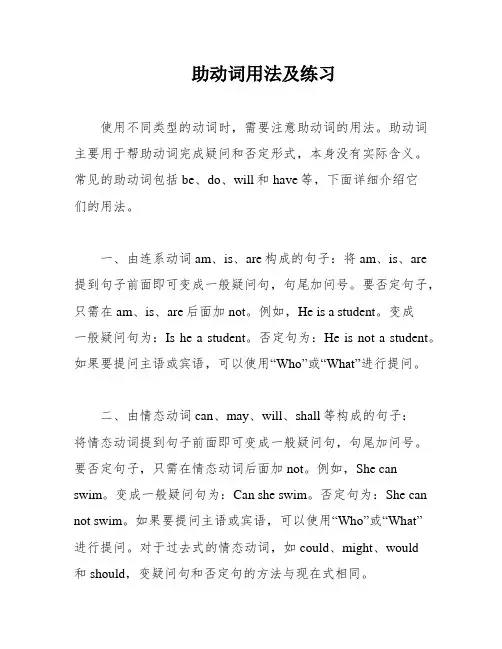
助动词用法及练习使用不同类型的动词时,需要注意助动词的用法。
助动词主要用于帮助动词完成疑问和否定形式,本身没有实际含义。
常见的助动词包括be、do、will和have等,下面详细介绍它们的用法。
一、由连系动词am、is、are构成的句子:将am、is、are 提到句子前面即可变成一般疑问句,句尾加问号。
要否定句子,只需在am、is、are后面加not。
例如,He is a student。
变成一般疑问句为:Is he a student。
否定句为:He is not a student。
如果要提问主语或宾语,可以使用“Who”或“What”进行提问。
二、由情态动词can、may、will、shall等构成的句子:将情态动词提到句子前面即可变成一般疑问句,句尾加问号。
要否定句子,只需在情态动词后面加not。
例如,She can swim。
变成一般疑问句为:Can she swim。
否定句为:She can not swim。
如果要提问主语或宾语,可以使用“Who”或“What”进行提问。
对于过去式的情态动词,如could、might、would和should,变疑问句和否定句的方法与现在式相同。
三、由行为动词构成的句子:需要使用助词do或does。
将do/does放在句子前面即可变成一般疑问句,句尾加问号。
要否定句子,只需在动词前面加don’t/doesn’t。
需要注意动词的形式,一般疑问句和否定句的动词三单式都要变回原型。
例如,play变成do,plays变成does。
They play football after school。
He also plays XXX.Do they play football after school。
Does he play football after school?XXX.Who plays football after school。
What do they do after school。
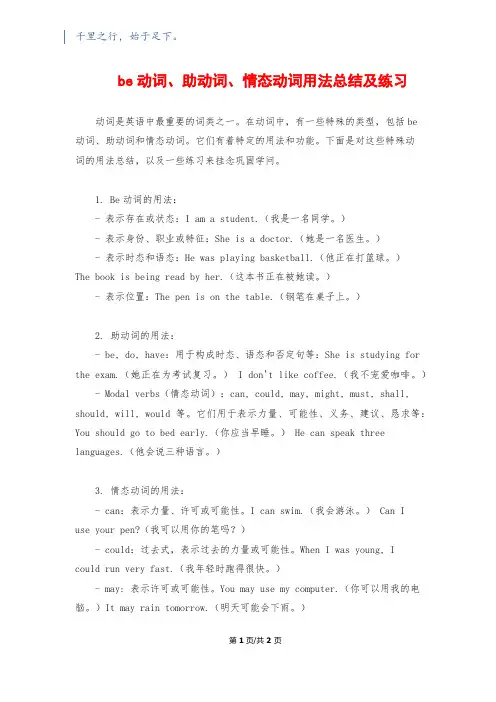
千里之行,始于足下。
be动词、助动词、情态动词用法总结及练习动词是英语中最重要的词类之一。
在动词中,有一些特殊的类型,包括be动词、助动词和情态动词。
它们有着特定的用法和功能。
下面是对这些特殊动词的用法总结,以及一些练习来挂念巩固学问。
1. Be动词的用法:- 表示存在或状态:I am a student.(我是一名同学。
)- 表示身份、职业或特征:She is a doctor.(她是一名医生。
)- 表示时态和语态:He was playing basketball.(他正在打篮球。
)The book is being read by her.(这本书正在被她读。
)- 表示位置:The pen is on the table.(钢笔在桌子上。
)2. 助动词的用法:- be, do, have:用于构成时态、语态和否定句等:She is studying for the exam.(她正在为考试复习。
) I don't like coffee.(我不宠爱咖啡。
)- Modal verbs(情态动词):can, could, may, might, must, shall, should, will, would等。
它们用于表示力量、可能性、义务、建议、恳求等:You should go to bed early.(你应当早睡。
) He can speak three languages.(他会说三种语言。
)3. 情态动词的用法:- can:表示力量、许可或可能性。
I can swim.(我会游泳。
) Can Iuse your pen?(我可以用你的笔吗?)- could:过去式,表示过去的力量或可能性。
When I was young, Icould run very fast.(我年轻时跑得很快。
)- may: 表示许可或可能性。
You may use my computer.(你可以用我的电脑。
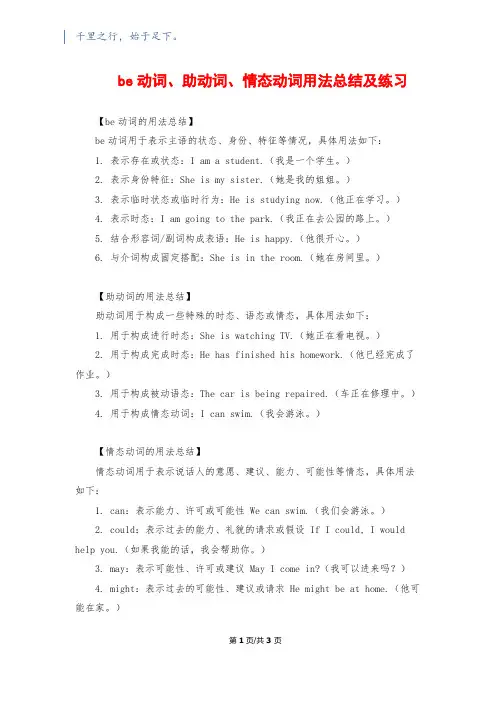
千里之行,始于足下。
be动词、助动词、情态动词用法总结及练习【be动词的用法总结】be动词用于表示主语的状态、身份、特征等情况,具体用法如下:1. 表示存在或状态:I am a student.(我是一个学生。
)2. 表示身份特征:She is my sister.(她是我的姐姐。
)3. 表示临时状态或临时行为:He is studying now.(他正在学习。
)4. 表示时态:I am going to the park.(我正在去公园的路上。
)5. 结合形容词/副词构成表语:He is happy.(他很开心。
)6. 与介词构成固定搭配:She is in the room.(她在房间里。
)【助动词的用法总结】助动词用于构成一些特殊的时态、语态或情态,具体用法如下:1. 用于构成进行时态:She is watching TV.(她正在看电视。
)2. 用于构成完成时态:He has finished his homework.(他已经完成了作业。
)3. 用于构成被动语态:The car is being repaired.(车正在修理中。
)4. 用于构成情态动词:I can swim.(我会游泳。
)【情态动词的用法总结】情态动词用于表示说话人的意愿、建议、能力、可能性等情态,具体用法如下:1. can:表示能力、许可或可能性 We can swim.(我们会游泳。
)2. could:表示过去的能力、礼貌的请求或假设 If I could, I would help you.(如果我能的话,我会帮助你。
)3. may:表示可能性、许可或建议 May I come in?(我可以进来吗?)4. might:表示过去的可能性、建议或请求 He might be at home.(他可能在家。
)第1页/共3页锲而不舍,金石可镂。
5. must:表示必须、推测、肯定或建议 You must finish your homework.(你必须完成作业。
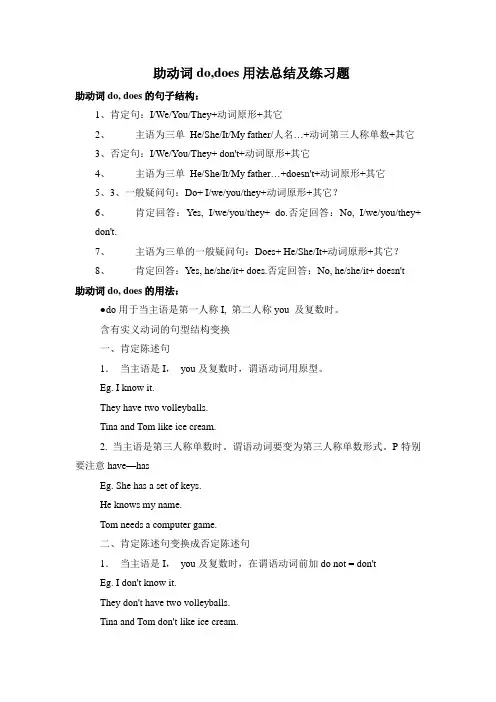
助动词do,does用法总结及练习题助动词do, does的句子结构:1、肯定句:I/We/You/They+动词原形+其它2、主语为三单He/She/It/My father/人名…+动词第三人称单数+其它3、否定句:I/We/You/They+ don't+动词原形+其它4、主语为三单He/She/It/My father…+doesn't+动词原形+其它5、3、一般疑问句:Do+ I/we/you/they+动词原形+其它?6、肯定回答:Yes, I/we/you/they+ do.否定回答:No, I/we/you/they+don't.7、主语为三单的一般疑问句:Does+ He/She/It+动词原形+其它?8、肯定回答:Yes, he/she/it+ does.否定回答:No, he/she/it+ doesn't助动词do, does的用法:●do用于当主语是第一人称I, 第二人称you 及复数时。
含有实义动词的句型结构变换一、肯定陈述句1.当主语是I,you及复数时,谓语动词用原型。
Eg. I know it.They have two volleyballs.Tina and Tom like ice cream.2. 当主语是第三人称单数时。
谓语动词要变为第三人称单数形式。
P特别要注意have—hasEg. She has a set of keys.He knows my name.Tom needs a computer game.二、肯定陈述句变换成否定陈述句1.当主语是I,you及复数时,在谓语动词前加do not = don'tEg. I don't know it.They don't have two volleyballs.Tina and Tom don't like ice cream.2. 当主语是第三人称单数时,在谓语动词前加does not = doesn't, 谓语动词打回原型Eg. She doesn't have a set of keys.He doesn't know my name.Tom doesn't need a computer game.三、肯定陈述句变换成一般疑问句采用“一加二变三问号”。
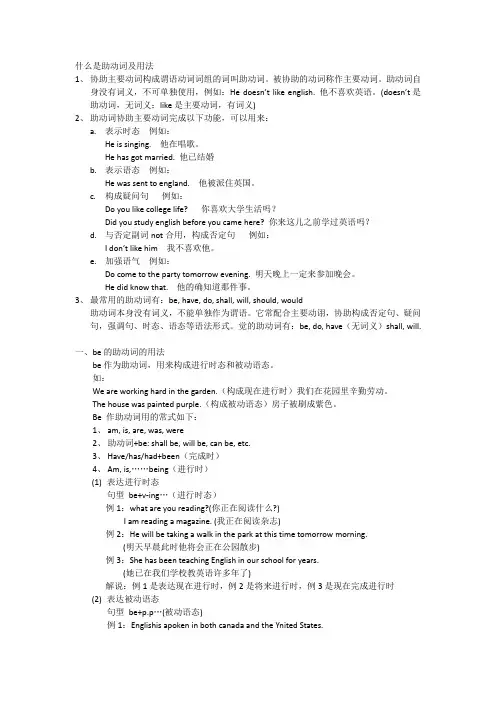
什么是助动词及用法1、协助主要动词构成谓语动词词组的词叫助动词。
被协助的动词称作主要动词。
助动词自身没有词义,不可单独使用,例如:He doesn’t like english. 他不喜欢英语。
(doesn’t是助动词,无词义;like是主要动词,有词义)2、助动词协助主要动词完成以下功能,可以用来:a.表示时态例如:He is singing. 他在唱歌。
He has got married. 他已结婚b.表示语态例如:He was sent to england. 他被派住英国。
c.构成疑问句例如:Do you like college life? 你喜欢大学生活吗?Did you study english before you came here? 你来这儿之前学过英语吗?d.与否定副词not合用,构成否定句例如:I don’t like him 我不喜欢他。
e.加强语气例如:Do come to the party tomorrow evening. 明天晚上一定来参加晚会。
He did know that. 他的确知道那件事。
3、最常用的助动词有:be, have, do, shall, will, should, would助动词本身没有词义,不能单独作为谓语。
它常配合主要动诩,协助构成否定句、疑问句,强调句、时态、语态等语法形式。
觉的助动词有:be, do, have(无词义)shall, will.一、be的助动词的用法be作为助动词,用来构成进行时态和被动语态。
如:We are working hard in the garden.(构成现在进行时)我们在花园里辛勤劳动。
The house was painted purple.(构成被动语态)房子被刷成紫色。
Be 作助动词用的常式如下:1、am, is, are, was, were2、助动词+be: shall be, will be, can be, etc.3、Have/has/had+been(完成时)4、Am, is,……being(进行时)(1)表达进行时态句型be+v-ing…(进行时态)例1:what are you reading?(你正在阅读什么?)I am reading a magazine. (我正在阅读杂志)例2:He will be taking a walk in the park at this time tomorrow morning.(明天早晨此时他将会正在公园散步)例3:She has been teaching English in our school for years.(她已在我们学校教英语许多年了)解说:例1是表达现在进行时,例2是将来进行时,例3是现在完成进行时(2)表达被动语态句型be+p.p…(被动语态)例1:Englishis apoken in both canada and the Ynited States.(加拿大和美国都讲英语)例2:Those keys were found in your drawer.(那些钥匙是在你的抽屉里找到的)例3:It can be done much faster in this way.(这件工作用这个方法可以更加快速地做好)二、Have 的助动词用法Have 作为助动,用来构成完成时态。
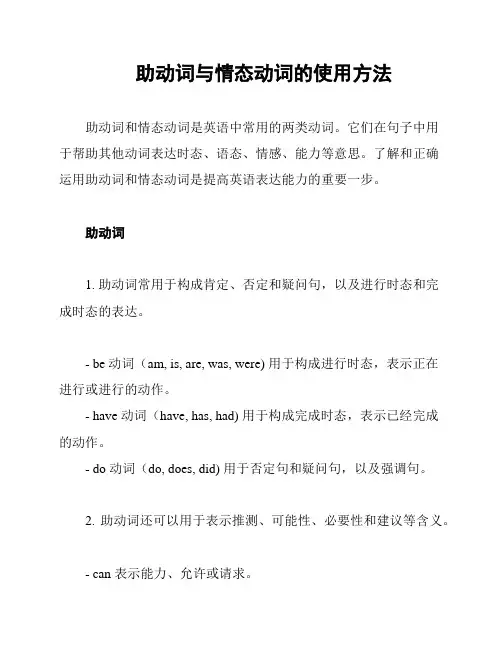
助动词与情态动词的使用方法助动词和情态动词是英语中常用的两类动词。
它们在句子中用于帮助其他动词表达时态、语态、情感、能力等意思。
了解和正确运用助动词和情态动词是提高英语表达能力的重要一步。
助动词1. 助动词常用于构成肯定、否定和疑问句,以及进行时态和完成时态的表达。
- be 动词(am, is, are, was, were) 用于构成进行时态,表示正在进行或进行的动作。
- have 动词(have, has, had) 用于构成完成时态,表示已经完成的动作。
- do 动词(do, does, did) 用于否定句和疑问句,以及强调句。
2. 助动词还可以用于表示推测、可能性、必要性和建议等含义。
- can 表示能力、允许或请求。
- could 表示过去的能力、允许或请求,也可用于委婉语气。
- may 表示许可、可能性或请求。
- might 表示过去的可能性或委婉语气。
- shall 表示义务、建议或请求。
- should 表示应该、建议或可能性。
- will 表示将来的意愿或行为。
- would 表示过去的意愿、惯或委婉语气。
情态动词1. 情态动词通常以原形形式出现,后面不再接动词的第三人称单数形式(-s),也不使用助动词 do。
2. 情态动词用于表示情感、能力、建议、义务、可能性等含义。
- can 表示能力、许可或请求。
- could 表示过去的能力、许可或请求,也可用于委婉语气。
- may 表示许可、可能性或请求。
- might 表示过去的可能性或委婉语气。
- shall 表示义务、建议或请求。
- should 表示应该、建议或可能性。
- will 表示将来的意愿或行为。
- would 表示过去的意愿、惯或委婉语气。
- must 表示必须、肯定性推测或强烈建议。
- ought to 表示应该、理应或强烈建议。
示例用法1. 助动词的用法示例:- She is studying for her exams.(进行时态)- They have visited Paris.(完成时态)- Do you like ice cream?(否定句)- Did he go to the party?(疑问句)- I do love chocolate!(强调句)2. 情态动词的用法示例:- You can speak English fluently.(能力)- Could you pass me the salt, please?(请求)- She may be late for the meeting.(可能性)- I should study for the exam.(建议)- They will arrive at 8 p.m.(将来意愿)- He must be tired after working all day.(肯定性推测)通过理解和熟练运用助动词和情态动词,我们可以更准确地表达自己的意思,并使句子更具表达力和准确性。
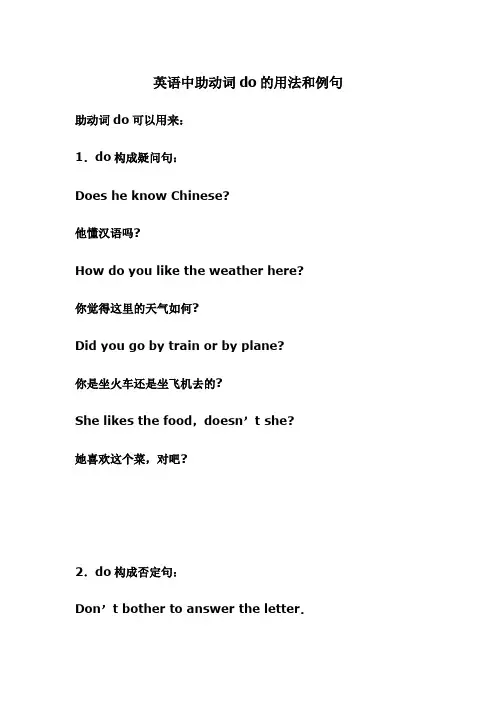
英语中助动词do的用法和例句助动词do可以用来:1.do构成疑问句:Does he know Chinese?他懂汉语吗?How do you like the weather here?你觉得这里的天气如何?Did you go by train or by plane?你是坐火车还是坐飞机去的?She likes the food,doesn’t she?她喜欢这个菜,对吧?2.do构成否定句:Don’t bother to answer the letter.不要烦你回信了。
We don’t see much of each other.我们不常见面。
He doesn’t care for fish.他不爱吃鱼。
I didn’t know you were here.我不知道你在这儿。
3.表示前面所说动作,以避免重复:Do you work together?–Yes.we do.你们在一起工作吗?足的。
(我们在一起工作。
)You don’t want to be late.Neither does she.你不想迟到,她也不想迟到。
You’re doing better than you did last term你这学期比上学期表现好。
I said he would fail,and he did.我说他会失败,他真的失败了。
加强语气(起强调作用):I do think you’re right.我确实认为你是对的。
She does feel that way.她确实有这种感觉。
She did say that.她确实这样说的。
Do be careful.千万小心。
do在更多情况下用作实意动词,用法很灵活,可表示许多意思,如:Martin has done an excellent article.马丁写了一篇精彩的文章。
He has done a portrait of Lilly.他画了一张丽丽的画像。
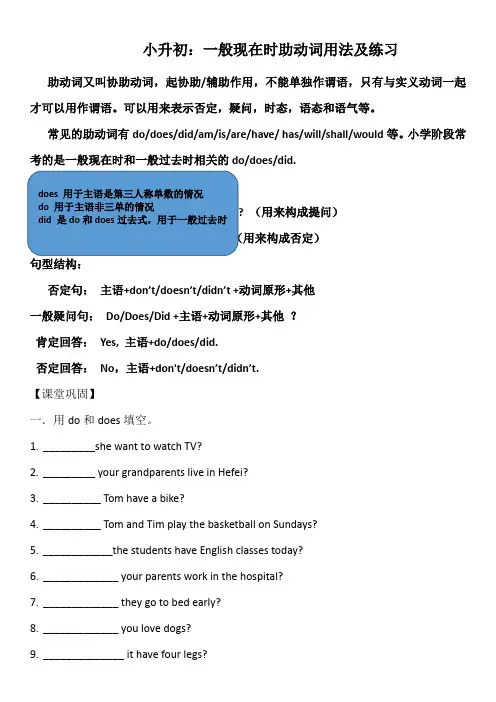
小升初:一般现在时助动词用法及练习助动词又叫协助动词,起协助/辅助作用,不能单独作谓语,只有与实义动词一起才可以用作谓语。
可以用来表示否定,疑问,时态,语态和语气等。
常见的助动词有do/does/did/am/is/are/have/ has/will/shall/would等。
小学阶段常考的是一般现在时和一般过去时相关的do/does/did.(用来构成提问)句型结构:否定句:主语+don’t/doesn’t/didn’t +动词原形+其他一般疑问句:Do/Does/Did +主语+动词原形+其他?肯定回答:Yes, 主语+do/does/did.否定回答:No,主语+don't/doesn’t/didn’t.【课堂巩固】一.用do和does填空。
1._________she want to watch TV?2._________ your grandparents live in Hefei?3.__________ Tom have a bike?4.__________ Tom and Tim play the basketball on Sundays?5.____________the students have English classes today?6._____________ your parents work in the hospital?7._____________ they go to bed early?8._____________ you love dogs?9.______________ it have four legs?10.____________the Greens live at King Street?11._____________ your sister like pink?12._____________your sisters study in the same school?13._____________the cat and the dog eat meat?14.He ______ want this book.15.Tom _______ go swimming on Sundays.16.My parents ________ like meat.17.Tom and Julia ________ play pingpong.18.Which season ______ you like ?19.What ______ you do?20.How ________ she go to school every day?21.How many basketballs ______ your brother have?22.The children _______ have English classes in the morning.23.My dad listens to the radio every evening,but he _______watch TV.24.Where ________ you live?25.I work harder than he __________.。
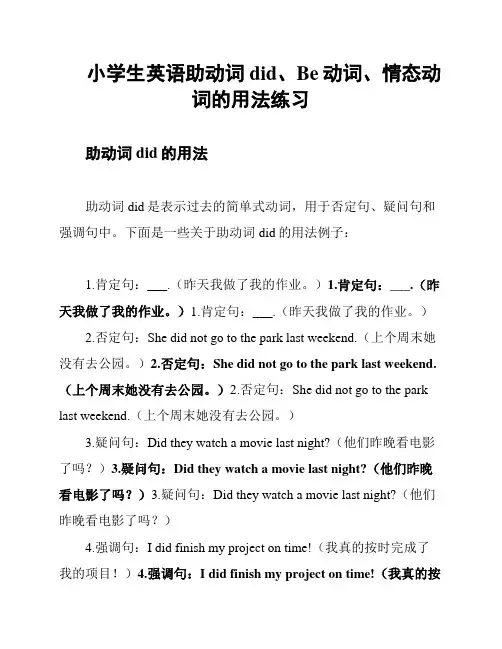
小学生英语助动词did、Be动词、情态动词的用法练习助动词did的用法助动词did是表示过去的简单式动词,用于否定句、疑问句和强调句中。
下面是一些关于助动词did的用法例子:1.肯定句:___.(昨天我做了我的作业。
)1.肯定句:___.(昨天我做了我的作业。
)1.肯定句:___.(昨天我做了我的作业。
)2.否定句:She did not go to the park last weekend.(上个周末她没有去公园。
)2.否定句:She did not go to the park last weekend.(上个周末她没有去公园。
)2.否定句:She did not go to the park last weekend.(上个周末她没有去公园。
)3.疑问句:Did they watch a movie last night?(他们昨晚看电影了吗?)3.疑问句:Did they watch a movie last night?(他们昨晚看电影了吗?)3.疑问句:Did they watch a movie last night?(他们昨晚看电影了吗?)4.强调句:I did finish my project on time!(我真的按时完成了我的项目!)4.强调句:I did finish my project on time!(我真的按时完成了我的项目!)4.强调句:I did finish my project on time!(我真的按时完成了我的项目!)Be动词的用法Be动词是表示状态、性质、身份和存在等的动词,包括am、is、are、was和were。
下面是一些关于Be动词的用法例子:1.肯定句:___ a ___.(他是一名老师。
)1.肯定句:___ a ___.(他是一名老师。
)1.肯定句:___ a ___.(他是一名老师。
)2.否定句:I am not tired.(我不累。
助动词与情态动词一、助动词助动词有be, have, do, will, shall。
它们本身没有词义,只和实义动词的一定形式构成复合谓语,用来表示时态和语态,构成否定、疑问及加强语气等。
1、be (am, is, are, were, been)(l)“be + -ing”构成进行时态;(2)“be + 过去分词”构成被动语态;(3)“be + 动词不定式”构成复合谓语:①表按计划安排要发生的事。
The prime minister is to visit Japan next year.总理将于明年访问日本。
②用于命令。
You're to do your homework before you watch TV.你得做完了作业才能看电视。
2、have (has, had)(1)“have+过去分词”构成完成时态。
如:Have you seen the film ?(2)“have been + -ing”构成完成进行时态。
如:What have you been doing these days? 这些日子你一直在干什么?3、do (does, did)(1)“do not + 动词原形”构成行为动词的否定式。
如:His brother doesn’tlike playing basket.;(2)“Do + 主语 + 动词原形”构成行为动词的一般疑问句。
Does he go toschool by bike every day? (3)“do + 动词原形”用于祈使句或陈述句中表示加强语气。
如:I did go to see him, but he wasn’t in我确实去看望他了,但他不在家。
Do do some work. 请一定做点什么;(4)代替前面刚出现的动词以避免重复。
My mother told me to go to bed early.So I did.4、will, shall (would, should)“will (shall+动词原形)”构成一般将来时,一般来说,shall用于第一人称,will用于第二人称或第三人称,口语中常用will代替shll,如:We will have a meeting to discuss the problem.二、情态动词情态动词表示说话人对某一动作或状态的态度,可以表示“可能”、“可以”、“需要”、“必须”或“应当”等之意。
助动词的用法我们已经知道,助动词的四种基本用法:(一)虚拟式用法这种用法常见于日常口语中。
通过助动词“要”、“会”、“应该”等使行为动作产生的结果得以实现,从而表达出说话人的意图。
例如:① She's going to china tomorrow。
她明天要去中国。
② I'll be good if you don't cheat。
你不许欺骗我。
③Where are they going to go?他们要到哪里去?④ That's all right。
那没关系。
⑤ How many children will you have?你有几个孩子?⑥ I only live for three years。
我只活三年。
⑦ I'm sure he won't come。
他一定不会来。
⑧ I'll give it to you。
给你吧。
(2)(1) You don't have to finish it, I'll finish it for you。
你不必全做完,我替你做完。
(2)He's always go, I can't tell if he's going to be late。
他总是迟到,我猜他迟早得迟到。
(3)I only live for three years。
我只活三年。
I've had enough of being an only child。
我受够了当独生子女。
(4) She says she has much to do。
她总是说忙,其实她什么事也没干。
(5) She tells me the truth。
她跟我讲真话。
I've met her once。
我曾经见过她一次。
(6) You're always late, it's a pity。
助动词用法大全助动词在语法中扮演着非常重要的角色,它不仅能够帮助句子表达出不同的时态、语气和意义,还能够构成不同的句型,丰富句子的表达方式。
助动词的用法涉及到时态、语态、情态、虚拟语气等多个方面,下面我们将整理助动词的用法大全,并详细解释。
一、时态1. 助动词"be"的时态用法:a. 现在进行时:I am eating dinner.(我正在吃晚饭。
)b. 过去进行时:They were playing basketball.(他们正在打篮球。
)c. 现在完成进行时:She has been reading for two hours.(她已经读了两个小时了。
)2. 助动词"do"的时态用法:a. 一般现在时:They do their homework every evening.(他们每天晚上都做作业。
)b. 一般过去时:I did my homework yesterday.(昨天我做了我的作业。
)c. 一般将来时:She will do her presentation tomorrow.(她明天将做她的演讲。
)3. 助动词"have"的时态用法:a. 现在完成时:We have finished our project.(我们已经完成了我们的项目。
)b. 过去完成时:He had visited the museum before it closed.(在博物馆关闭之前, 他已经去过了。
)二、语态1. 助动词的被动语态:a. 现在被动语态:The book is being read by me.(这本书正在被我读。
)b. 过去被动语态:The house was built by my grandfather.(这栋房子是我爷爷建造的。
)2. 助动词的进行时被动语态:a. 现在进行时被动语态:The car is being repaired by the mechanic.(这辆车正在被修理工修理。
助动词一.概念:助动词是帮助主要动词构成各种时态,语态,语气以及否定或疑问结构的动词.助动词分为时态助动词和结构助动词两种.二.相关知识点精讲:1. 助动词be的用法1)be +现在分词,构成进行时态。
例如:They are having a meeting.他们正在开会。
English is becoming more and more important. 英语现在越来越重要。
2)be + 过去分词,构成被动语态。
例如:The window was broken by Tom..窗户是汤姆打碎的。
English is taught throughout the world.世界各地都教英语。
3)be + 动词不定式,可表示下列内容:a. 表示最近、未来的计划或安排。
例如:He is to go to New York next week..他下周要去纽约。
We are to teach the freshmen.我们要教新生。
说明:这种用法也可以说成是一种将来时态表达法。
b. 表示命令。
例如:You are to explain this.对此你要做出解释。
He is to come to the office this afternoon.要他今天下午来办公室。
c.征求意见。
例如:How am I to answer him?我该怎样答复他?Who is to go there?谁该去那儿呢?d. 表示相约、商定。
例如:We are to meet at the school gate at seven tomorrow morning.我们明天早晨7点在校门口集合。
2. 助动词have的用法1)have +过去分词,构成完成时态。
例如:He has left for London.他已去了伦敦。
By the end of last month, they had finished half of their work.上月未为止,他们已经完成工作的一半。
助动词do/does的用法专题助动词do与does口诀(一)(do ) 变句型,先观察,述句中动用原, 一般疑问do提前,否定don’t 实动前。
(二)(does) 若是主语为三单,述句中动变形,一般疑问也简单,does放在句子前,否定doesn’t实动前,主动出现动还原。
总结:含有实义动词的句子,进行句子转换时应借助于助动词do/does,主语是三单(he,she,it)时用does,其他用do。
否定句在动词原形前加don’t /doesn’t,一般疑问句把do/does 提前,特殊疑问句由特殊疑问词+一般疑问句。
句子类型及结构肯定句:主语+动词+其它。
主语是三单,动词用三单I like this blue sweater. Tom likes this blue sweater.我喜欢这件蓝色的毛衣。
Tom喜欢这件蓝色的毛衣。
Tom likes English.Tom喜欢英语。
I like this blue sweater.Tom likes English.否定句:主+ don’t/doesn’t+动原+其它I don’t like this blue sweater.我不喜欢这件蓝色的毛衣。
Tom doesn’t like English.Tom不喜欢英语。
I like this blue sweater.Tom likes English.一般疑问句:do/does提前,其它照抄不变(Do /Does+主+动原+其它?),一人称变二人称。
回答:Yes,主+do/does. No,主+ don’t/doesn’t.Do you like this blue sweater?Yes, I do. / No, I don’t.你喜欢这件蓝色的毛衣吗?是的,我喜欢; 不,我不喜欢。
Does Tom like English?Yes,he does. /No.he doesn’t.Tom喜欢英语吗?是的,他喜欢;不,他不喜欢。
小学生英语助动词do、Are动词、情态动词的用法练习助动词(do)、动词(be)和情态动词(modal verbs)是研究英语的基础知识点。
在这份练文档中,我们将研究这些动词的用法。
一、助动词(do)的用法1. do作为助动词主要用于构成否定句和疑问句。
例如:- He does not like ice cream.(他不喜欢冰淇淋。
)- Do you like pizza?(你喜欢比萨吗?)2. do还可以用来表示强调。
例如:- I do love playing soccer.(我真的很喜欢踢足球。
)二、动词(be)的用法1. 用于表示存在、状态和身份。
例如:- I am a student.(我是一个学生。
)- They are at the park.(他们在公园。
)2. 动词(be)也可以用于构成进行时态。
例如:- She is studying English.(她正在学英语。
)三、情态动词(modal verbs)的用法1. can用来表示能力、许可和可能性。
例如:- I can run very fast.(我跑得很快。
)- Can I go to the bathroom?(我可以去上厕所吗?)2. must用来表示必须和推测。
例如:- You must finish your homework before you watch TV.(你必须先完成作业,然后才能看电视。
)- She must be tired because she stayed up late.(她一定很累,因为她熬夜了。
)3. should用来表示建议和义务。
例如:- You should eat more fruits and vegetables.(你应该多吃水果和蔬菜。
)- We should help others in need.(我们应该帮助需要帮助的人。
)四、练题1. 请用do的正确形式填空:I ___ my homework every day.2. 把下面的句子改成否定句:She likes swimming.3. 请用can的正确形式填空:He ___ speak English fluently.4. 把下面的句子改成一般疑问句:They are students.5. 请用should的正确形式填空:We ___ be kind to others.答案:1. do2. She does not like swimming.3. can4. Are they students?5. should希望这份练习能够帮助你巩固助动词(do)、动词(be)和情态动词(modal verbs)的用法。
be动词,情态动词,助动词do/does的用法区别及练习助动词,顾名思义就是帮助动词完成疑问及否定的,本身没有什么含义。
主要的助动词有be,do,will,have等,其用法详述如下:一、⑴由连系动词am,is,are构成的句子:变一般疑问句时把am,is,are提到句子的前面,句尾用问号即可。
变否定句时直接在am,is,are后面加not 即可。
例如:肯定句:He is a student.一般疑问句: Is he a student否定句: He is not a student.画线提问: 对he提问: Who is a student对 a student 提问: What is he(2)was 是am,is的过去式,were是are的过去式,若句子中有以上两词时,变疑问句及否定句方法与(1)相同。
二、(1) 由情态动词can, may,will ,shall等构成的句子: 变一般疑问句时把can, may,will ,shall提到句子的前面,句尾用问号即可.变否定句时直接在can,may,后面加not即可. 例如:肯定句: She can swim.一般疑问句: Can she swim否定句: She can not swim.画线提问: 对she提问: Who can swim对swim提问: What can she do(2)could,might,would,should是can,may,will,shall的过去式,若句子中有以上两词时,变疑问句及否定句方法与(1)相同。
三、(1)由行为动词构成的句子: 需要加助词do或does. 变一般疑问句时把do/does放在句子前面. 变否定句时把don’t/doesn’t放在动词的前面。
要注意观察动词的形式并对号入座。
一般疑问句和否定句的动词三单式都要变回原型。
play-----do plays-----does例如:肯定句: They play football after school. He plays football after school.一般疑问句: Do they play football after school Does he play football after school否定句: They don't (do not) play footba ll after school. He doesn’t’ play football after school.画线提问: 对they/he提问: Who plays football after school对play football提问: What do they do after school What does he do after school对after school提问: When do they play football When does he play football(2)did是do和did的过去式,变一般疑问句时把did放在句子前面. 变否定句时把didn’t放在动词的前面, 要注意观察动词的形式并对号入座。
一般疑问句和否定句的动词都要变回原型。
四、(1)由have,has构成的现在完成时句子,变一般疑问句时把have,has提到句子的前面,句尾用问号即可。
变否定句时直接在have,has后面加not即可。
例如:肯定句:He has read today’s newspaper.一般疑问句: Has he read today’s newspaper.否定句: He has not read today’s newspape画线提问: 对he提问: Who has read today’s newspaper对today’s newspaper提问: What has he did(2)had是have和has的过去式,在构成的过去完成时句子中,变一般疑问句时把had提到到句子的前面,句尾用问号即可。
变否定句时直接在had后面加not即可。
(3)若have,has,had没有出现在完成时的句子中,则当实义动词对待,请参考实义动词的用法。
五、第一人称I,we在变疑问句时,应变为第二人称you。
“I am, you /we /they are”这是初一最简单的固定搭配,不应再唠叨了吧!六、is,has,does用于第三人称的现在时态,was用于第三人称的过去时态。
针对性练习按要求改写句子:have been to Beijin(一般疑问句)______ ______ __________ to Beijincan see some birds.(一般疑问句)______ ______ see ______ birdsdesigns clothes.(一般疑问句)______ he ________ clotheswere s ome flowers on the teachers’ desk.(一般疑问句) ______ ______ ______ flowers on the teachers’ desk were some apples on the tree.(否定句)There ______ ______ ______ apples on the tree.think he is very old.(否定句)I ______ think he ______ very old.colour it green.(否定句)______ ______ colour it green.had lunch(变否定句)______ _______ ______ __________.may have some hot dogs.(一般疑问句)_______ ______ ______ ______ ________.aren’t any pears in the box.(同义句)There are ______ pears in the box.sign means “No smoking”.What ______ this sign _________has already written the letter.(改为否定句)she____ _____was young.(改为一般疑问句)______ ______ ____________pencils are in the pencil-box.(对划线部分提问)______ ______ your pencilsgot up at six yesterday(对划线部分提问)______ ______ __________ you get up yesterdayliked to walk home.(改为一般疑问句)______ they ________ _______ _______ _________are cars.(用buses改写成选择疑问句)Are these cars______ ______plant is one month old.(就划线部分提问)_______ ______ ______ _______ plantboys are in our house.(改为there be句型)______ ______ two boys in our house.plant has two green leaves. (就划线部分提问)_______ ______ _______ ______ ______ _______plant __________Li goes to Hong Kong by plane.(同义句)Miss Li ________ _________ Hong Kong.22. The women worked in the shoe factory.(就划线部分提问)_______ _______ ______ women __________is happy, because he is going to take a trip tomorrow.(就划线部分提问)_______ _______ ______ _________father can cook the meals.(就划线部分提问)_______ ________ ________ father __________25. You should add water often.(一般疑问句)_______ ______ _______ water often一、变否定句时相关词的改变肯定句变否定句时,除将谓语变为否定式外,句中其他词语也可能随之改变,如将some改为any,too和also改为either,already改为yet,and改为or等:There are some birds in the tree. 树上有些鸟。
→There aren’t any birds in the tree. 树上没有鸟。
He likes the girl, too. 他也喜欢这个女孩。
→He doesn’t like the girl, either. 他也不喜欢这个女孩。
We have already seen the film. 我们已看过这部电影。
→We have not seen the film yet. 我们没有看这部电影。
He likes singing and dancing. 他喜欢唱歌和跳舞。
→He doesn’t like singing or dancing. 他不喜欢唱歌也不喜欢跳舞。
二、部分否定与完全否定比较以下句子:All of us laughed when we heard it. 听到这事时我们都笑了。
(肯定句)All of us didn’t laughed when we heard it. 听到这事时我们并未都笑。
(部分否定)Not all of us laughed when we heard it. 听到这事时我们并未都笑。
(部分否定)None of us laughed when we heard it. 听到这事时我们都没笑。
(完全否定)【注】可能涉及部分否定的词语有both, all, always, every等,即not both表示“并非两者都”,not all 表示“并非所有的都”,not always 表示“并非总是”,not every 表示“并非每个…都”。
练习答案:1.Have you been,2. Can you any, design, there any, not any, ’t is,don’t, didn’t have lunch, you have any hot dogs, , mean,not written the letter yet, she young, are, time did , like to walk home, ’t they, old is you plant, 19,There are , many green leaves does you have, to, did the work, is he happy, can you do,you add.。